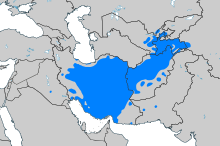Tiếng Ba Tư
ngôn ngữ Tây Iran From Wikipedia, the free encyclopedia
Tiếng Ba Tư hay tiếng Persia, còn được biết đến như tiếng Farsi (فارسی fārsi [fɒːɾˈsiː] ⓘ), là một ngôn ngữ Iran thuộc ngữ tộc Ấn-Iran của hệ ngôn ngữ Ấn-Âu. Nó chủ yếu được nói ở Iran, Afghanistan (dưới tên gọi tiếng Dari từ năm 1958),[8] và Tajikistan (tên gọi tiếng Tajik vào thời Xô Viết ),[9] và một vài vùng khác về mặt lịch sử được xem là thuộc đế quốc Ba Tư. Tiếng Ba Tư, nói chung, được viết bằng chữ Ba Tư, một biến thể của chữ Ả Rập.
Bài viết hoặc đoạn này cần người am hiểu về chủ đề này trợ giúp biên tập mở rộng hoặc cải thiện. (tháng 2/2022) |
| Tiếng Ba Tư | |
|---|---|
| Fārsi | |
| فارسی | |
 Fārsi viết bằng chữ Ba Tư-Ả Rập | |
| Phát âm | [fɒːɾˈsiː] |
| Sử dụng tại |
|
| Tổng số người nói | 45 triệu (2007)[6] – 60 triệu (2009)[5] người bản ngữ Tổng cộng 110 triệu.[5] |
| Phân loại | Ấn-Âu |
| Ngôn ngữ tiền thân | Tiếng Ba Tư cổ
|
| Dạng chuẩn | |
| Phương ngữ |
Bukhara
Pahlavan
Hazara
Aimaq
Ba Tư Do Thái
Dehwar
Tat Do Thái[5]
Tat Armenia[5]
|
| Hệ chữ viết |
|
| Địa vị chính thức | |
Ngôn ngữ chính thức tại | Iran (dưới tên "tiếng Ba Tư") Afghanistan (dưới tên tiếng Dari) Tajikistan (dưới tên tiếng Tajik) |
| Quy định bởi |
|
| Mã ngôn ngữ | |
| ISO 639-1 | fa |
| per (B) fas (T) | |
| ISO 639-3 | tùy trường hợp:pes – Tiếng Tây Ba Tưprs – Tiếng Dari (Ba Tư Afghan)tgk – Tiếng Tajikaiq – Phương ngữ Aimaqbhh – Phương ngữ Bukhorahaz – Phương ngữ Hazarajpr – Tiếng Ba Tư Do Tháiphv – Phương ngữ Pahlavandeh – Tiếng Dehwarjdt – Tiếng Tat Do Tháittt – Tiếng Tat (Kavkaz) |
| Glottolog | fars1255[7] |
| Linguasphere | |
 Khu vực nơi có số người nói Ba Tư đáng kể (tính cả phương ngữ). | |
 Các quốc gia nơi tiếng Ba Tư là ngôn ngữ chính thức. | |
Tiếng Ba Tư hiện đại là sự tiếp nối của tiếng Ba Tư trung đại, ngôn ngữ tôn giáo và văn học chính thức của Đế chế Sassanid, mà chính nó lại là hậu thân của tiếng Ba Tư cổ, ngôn ngữ của Đế chế Achaemenes.[10][11][12] Ngữ pháp của nó tương đồng với nhiều ngôn ngữ của châu Âu đương thời.[13]
Tiếng Dari của Afghani đã bị pha trộn rất nhiều với các ngôn ngữ như tiếng Mông Cổ.[14]
Có chừng 110 triệu người nói tiếng Ba Tư trên toàn cầu và ngôn ngữ này có vị thế chính thức tại Iran, Afghanistan, và Tajikistan. Trong nhiều thế kỷ, tiếng Ba Tư cũng là ngôn ngữ văn hóa tại nhiều vùng ở Tây Á, Trung Á, và Nam Á.[15]
Tiếng Ba Tư đã ảnh hưởng (chủ yếu về từ vựng) một cách đáng kể lên nhiều ngôn ngữ xung quanh, nhất là các ngôn ngữ Turk miền Trung Á, Kavkaz, và Tiểu Á, những ngôn ngữ Iran lân cận, cũng như tiếng Armenia, tiếng Gruzia, vài ngôn ngữ Ấn-Iran khác, đặc biệt là tiếng Urdu (một dạng tiếng Hindustan). Nó cũng ảnh hưởng phần nào lên tiếng Ả Rập, nổi bật nhất là ở tiếng Ả Rập Bahran.[16] Ngược lại, tiếng Ba Tư cũng mượn rất nhiều từ trong tiếng Ả Rập sau cuộc xâm lược Ba Tư của người Ả Rập.[10][13][17][18][19][20]
Nguồn gốc và phát triển
Tiếng Ba Tư bắt nguồn từ tiếng Ba Tư cổ, ngôn ngữ của Đế chế Achaemenes (khoảng 550 - 330 TCN). Tiếng Ba Tư cổ được ghi chép bằng chữ viết Ba Tư cổ, một hệ thống chữ viết dựa trên chữ hình nêm. Sau khi Alexander Đại đế chinh phục Ba Tư, tiếng Hy Lạp bắt đầu ảnh hưởng đến tiếng Ba Tư cổ, dẫn đến sự hình thành tiếng Ba Tư trung đại, hay tiếng Pahlavi (khoảng 224 TCN - 651 SCN).
Tiếng Ba Tư trung đại được sử dụng dưới triều đại Sassanid (224 - 651 SCN) và trở thành ngôn ngữ chính thức của đế chế. Trong thời kỳ này, tiếng Ba Tư chịu ảnh hưởng từ tiếng Ả Rập, đặc biệt là sau cuộc xâm lược Hồi giáo vào thế kỷ thứ 7. Hệ thống chữ viết Ba Tư-Ả Rập được phát triển dựa trên chữ Ả Rập, thay thế cho chữ viết Pahlavi.
Tiếng Ba Tư hiện đại bắt đầu phát triển từ thế kỷ thứ 9 SCN. Ngôn ngữ này tiếp tục chịu ảnh hưởng từ tiếng Ả Rập, cũng như tiếng Thổ Nhĩ Kỳ và tiếng Mông Cổ. Tiếng Ba Tư hiện đại có nhiều phương ngữ khác nhau, được sử dụng ở Iran, Afghanistan, Tajikistan, Uzbekistan và một số quốc gia khác.
Chú thích
Liên kết ngoài
Đọc thêm
Liên kết ngoài
Wikiwand - on
Seamless Wikipedia browsing. On steroids.
